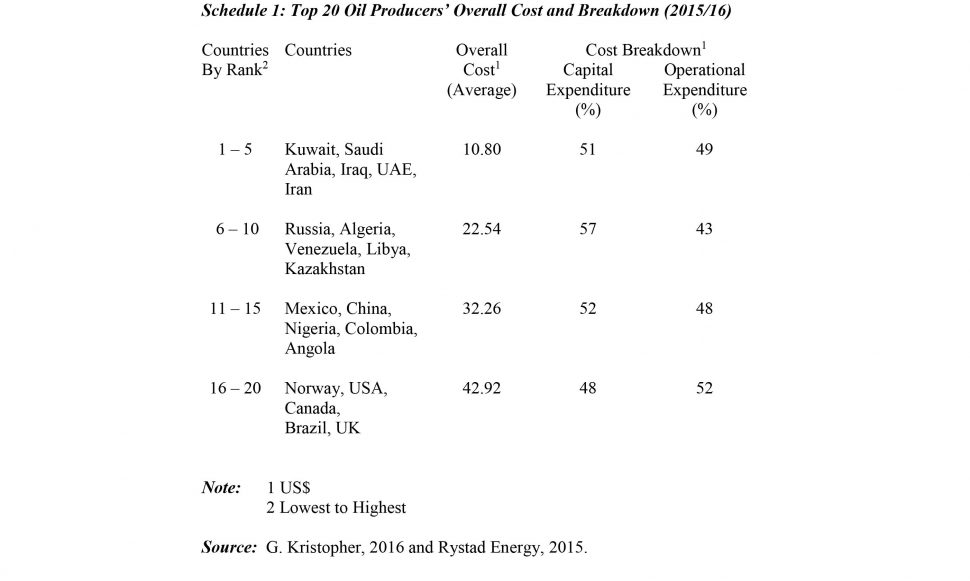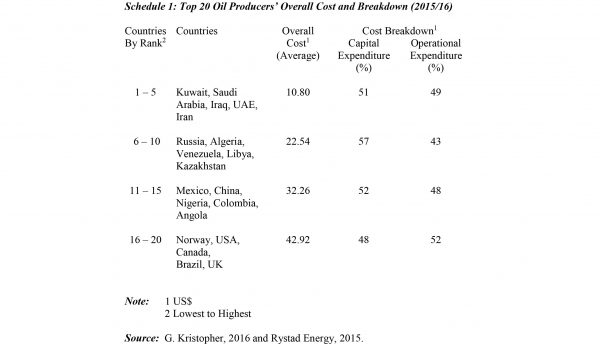Under Guidepost 6 of Guyana’s Petroleum Road Map, in its dimension for “getting petroleum revenues” I have offered, thus far, three sets of unit cost metrics, which were completed in 2018. These are: 1) Hess Corporation’s ‘Power Energy’ Conference Paper (September 2018) 2) the University of Trinidad and Tobago’s (U of T&T) Modelling Presentation to the Society of Petroleum Engineers Conference, 2018 and 3) Open Oil’s FAST modelling of the Liza Field Development, March 2018. Today’s column introduces to the discussion the “broader global material”, which I had referred to last week. This material has aided my determination of an appropriate unit cost range, to be applied, when estimating Guyana’s projected petroleum revenues. For this reason I spell this material out in some detail in today’s column.
Before introducing that broader global material however, I first offer further observations on the estimation of Guyana’s unit cost, as in the two models referenced above: (U of T&T and Open Oil).
U of T&T Model
The U of T&T’s “representative model”, as it is termed, explicitly addresses cost through its assumptions on operational expenditure (OPEX). The Paper states: “The oil OPEX had an escalation factor of two percent (2%) assigned but the maximum oil OPEX was constrained to half of the associated oil price” (my emphasis).
Because three prices were modelled, namely 45, 50 and 65 US dollars per barrel of oil equivalent (boe), these yield separate cost constraints of 22.50, 25.00 and 32.50 US dollars per boe, respectively. The mean of the three prices is US$53.33; and therefore, the mean of the three cost constraints is US$26.67 per boe.
I shall return to these estimates later, when I am providing my estimate of Guyana’s unit cost range.
Open Oil FAST Model
Importantly, Open Oil’s model devotes significant discussion to the internal rate of return (IRR) of Liza Phase 1. As a “measure of an investment’s internal rate of return”; the IRR excludes external considerations, such as risk, inflation or the cost of capital. The IRR is therefore, identical to the discounted cash flow rate of return.
The Open Oil model reports that 15 percent is the typical “hurdle rate” for investors in the petroleum sector. Consequently, it identifies a “sweet spot IRR” for the Government of Guyana (GoG) of 15-25 percent. This “sweet spot” is considered high enough to encourage more investment in Guyana’s petroleum sector, without yielding “windfall profits” (or economic rent) to investors.
The model also estimates the Liza 1 IRR at 19.6 percent, for a price of US$65 per boe. The model further finds that, the IRR is responsive to field size. Thus, a field size of 1 billion barrels of oil as against the 450 million boe, modelled by Open Oil, sees the IRR jump to 37.7 percent, ceteris paribus!
The Broader Global Material
The “cost-price relation”, expected to emerge as Guyana commercializes its petroleum “discoveries”, remains to today an indicative exercise; simply because full commercialization has not yet occurred. Nonetheless, from the perspective of the likely industry’s cost-price relation it is safe to posit, the greater is the positive difference between the overall unit costs of producing and distributing oil and gas and their market prices, the greater is the potential benefit for all beneficiaries, including the GoG.
Back in 2016 (October 23) when this observation was first made, I did not have the benefit of the 2018 Guyana modelling exercises. I had therefore, introduced readers to a Schedule (reproduced below) showing the overall average unit cost of oil production for the top 20 producing nations worldwide. These data form the broader global material. They are derived from operations in over 15,000 separate oil fields! Further, the Schedule computes costs separately as capital and operational expenditures.
As previously indicated, I have organized the data into four groups of five countries each; ranked from the lowest overall unit cost (1-5) to the highest (16-20). The overall unit cost for each group represents a simple average of the reported overall cost for the 5 members of the group. This overall cost is further broken down into capital and operational expenditures.
What the data reveal?
First, the overall unit cost for the five highest cost producers’ group is four times larger than the lowest cost. Second, the country with the lowest overall unit cost, Kuwait @ US$8.50 has a cost less than one-sixth that of the highest; the United Kingdom @ US$52.51. Third, the range in overall unit costs is US$44.00. Fourth, the mean of the overall unit cost values is US$27.10. Fifthly, the median value is US$28.50. And, finally, variation in the overall unit costs is quite strong. For example, the mean absolute deviation is 10.50 and the coefficient of variation in the values is 0.474 and the relative standard deviation is 47.4 percent.
Relatedly, the average percentage distribution between capital expenditure and operational expenditure for all four groups of countries is 52:48. The data do not indicate a unique relationship between the size of national production and this ratio, except perhaps that the ratio is the worst (48:52) for the highest cost producers! However, the ratio does not consistently worsen across all four groups of countries, as their average size of production increases.
Conclusion
I have referenced this broader global material, because, as readers will observe in coming weeks, it plays a significant role in my depiction of both the lower and higher values of the indicative unit cost range that I shall propose. Before addressing that topic however, I need to offer next, a few comments on the notion of a “break-even price”. This concept relates specifically to the sustainability of Guyana’s oil and gas sector, which is at the heart of the industry’s cost-price relation!








